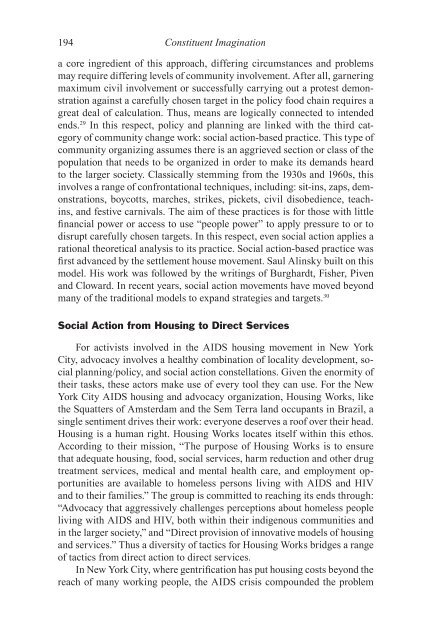CONSTITUENT IMAGINATION - autonomous learning
CONSTITUENT IMAGINATION - autonomous learning
CONSTITUENT IMAGINATION - autonomous learning
Create successful ePaper yourself
Turn your PDF publications into a flip-book with our unique Google optimized e-Paper software.
194 Constituent Imagination<br />
a core ingredient of this approach, differing circumstances and problems<br />
may require differing levels of community involvement. After all, garnering<br />
maximum civil involvement or successfully carrying out a protest demonstration<br />
against a carefully chosen target in the policy food chain requires a<br />
great deal of calculation. Thus, means are logically connected to intended<br />
ends. 29 In this respect, policy and planning are linked with the third category<br />
of community change work: social action-based practice. This type of<br />
community organizing assumes there is an aggrieved section or class of the<br />
population that needs to be organized in order to make its demands heard<br />
to the larger society. Classically stemming from the 1930s and 1960s, this<br />
involves a range of confrontational techniques, including: sit-ins, zaps, demonstrations,<br />
boycotts, marches, strikes, pickets, civil disobedience, teachins,<br />
and festive carnivals. The aim of these practices is for those with little<br />
financial power or access to use “people power” to apply pressure to or to<br />
disrupt carefully chosen targets. In this respect, even social action applies a<br />
rational theoretical analysis to its practice. Social action-based practice was<br />
first advanced by the settlement house movement. Saul Alinsky built on this<br />
model. His work was followed by the writings of Burghardt, Fisher, Piven<br />
and Cloward. In recent years, social action movements have moved beyond<br />
many of the traditional models to expand strategies and targets. 30<br />
Social Action from Housing to Direct Services<br />
For activists involved in the AIDS housing movement in New York<br />
City, advocacy involves a healthy combination of locality development, social<br />
planning/policy, and social action constellations. Given the enormity of<br />
their tasks, these actors make use of every tool they can use. For the New<br />
York City AIDS housing and advocacy organization, Housing Works, like<br />
the Squatters of Amsterdam and the Sem Terra land occupants in Brazil, a<br />
single sentiment drives their work: everyone deserves a roof over their head.<br />
Housing is a human right. Housing Works locates itself within this ethos.<br />
According to their mission, “The purpose of Housing Works is to ensure<br />
that adequate housing, food, social services, harm reduction and other drug<br />
treatment services, medical and mental health care, and employment opportunities<br />
are available to homeless persons living with AIDS and HIV<br />
and to their families.” The group is committed to reaching its ends through:<br />
“Advocacy that aggressively challenges perceptions about homeless people<br />
living with AIDS and HIV, both within their indigenous communities and<br />
in the larger society,” and “Direct provision of innovative models of housing<br />
and services.” Thus a diversity of tactics for Housing Works bridges a range<br />
of tactics from direct action to direct services.<br />
In New York City, where gentrification has put housing costs beyond the<br />
reach of many working people, the AIDS crisis compounded the problem
















